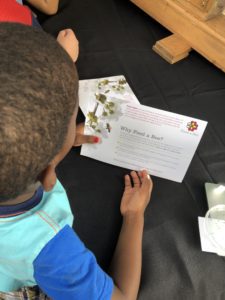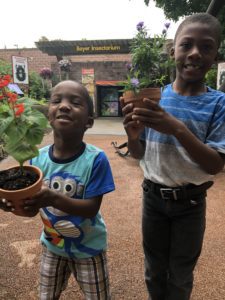I have two little boys 4 & 6, who when it comes to the outdoors and nature are exact opposites. My oldest is terrified of pretty much any bug, he doesn’t like to dig in the dirt or explore much. On the other hand, my little one seeks it out. Often times whatever little bug he first sees, ends up getting scooped up into his hands and he insists upon carrying it around with him. He loves to help me garden and pull weeds. I love his sense of adventure and curiosity when it comes to nature.
Recently, my boys and I attended a #FeedABee event hosted by Bayer at the Saint Louis Zoo. They had the event set up right outside the insectarium which was perfect. We were able to learn about the honey bees outside and then head on inside to see all sorts of other creatures. The Feed a Bee initiative has been spurred by Bayer’s continued research on the main stressors on the honey bee population and what we can do to help.

While at the event we learned about the top two current honey bee stressors:
The Varroa mite, originally native to Asia, is the most destructive stressor to the Western honey bee. If a hive is infested it only takes up to three years for it to die off. Additionally, the mite can also transmit secondary infections and diseases to the bee colony. The mite can then spread from hive to hive through bees interacting with different colonies. The boys got to see the actual mites using a microscope while we were there as well as a honey bee colony.
Aside from the Varroa mite, the other top stressor for bee populations is lack of adequate nutrition. Pollinator foraging areas in the United States are not only shrinking, but lacking in diversity, which then impacts bee’s nutrition.
So, what can you do?
Plant more flowers! Which is exactly what the Feed a Bee initiative is all about. Bayer’s main goal is to educate people about the importance of honey bees and to increase their availability for nutrition through flowers. It doesn’t have to be a field of pollinator-attracting plants covering the back yard. Do you have a patio that could use a couple of potted plants? Or a window that could hold a planter box? All flowers help, the more diverse flowers planted means the more diverse food options available to the bees.

My boys loved being able to pick out a flower, decorate their own pot, and then find a spot for it on our front porch. Since, we were able to see the honey bees up close, and even spot the Queen, my littles have been peeking out the front window constantly to see if their flowers are attracting any bees. Even if my oldest doesn’t seek out nature quite like my little one, going to events like #FeedABee helps him learn a little bit more about all of the wonderful things that nature and creatures like the honey bees do for us.
You can check out what Bayer is doing regarding their research initiatives and find out more about how you can help on-line at https://beehealth.bayer.us/who-can-help.
This post is sponsored by Bayer but all opinions are the writer’s own.










